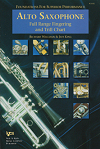
|
S714: Alto Saxophone Full Range Fingering and Trill Chart by Richard Williams and Jeff King. Kjos, 1999, SS, 7 pages. This is a handy 6" x 9" fingering chart on glossy card stock. It gives the standard fingerings and alternatives from low B-flat to altissimo C with two options for each note beginning with altissimo E. It also has trills to altissimo F.
Free Media Mail shipping on this music to US, IF ordered with another item.
(Except other items with free shipping.)
|
3.95

|
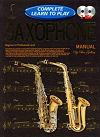
|

  S119: Complete Learn to Play Saxophone Manual by Peter Gelling. LPT Publishing, 2003, PB, 216 pages + CDs for both alto and tenor saxophone. The first 12 chapters are identical to the contents of Progressive Saxophone (S118) but it continues for a further 36 chapters, about three quarters of the book. The additional material covers the full chromatic scale, high notes, transposing, intervals, scales and arpeggios, and many jazz techniques. S119: Complete Learn to Play Saxophone Manual by Peter Gelling. LPT Publishing, 2003, PB, 216 pages + CDs for both alto and tenor saxophone. The first 12 chapters are identical to the contents of Progressive Saxophone (S118) but it continues for a further 36 chapters, about three quarters of the book. The additional material covers the full chromatic scale, high notes, transposing, intervals, scales and arpeggios, and many jazz techniques.
|
29.95

|
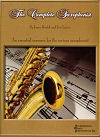 |
S369: The Complete Saxophonist by James Houlik and Eric Lauver. Northeastern Music Publications, 2007, SS, 44 pages pages + CD. Subtitled: An essential resource for the serious saxophonist. While this book calls itself a method book and has the the basic information on equipment and care one might expect, it is not a step-by-step method for learning to play the saxophone. Instead it focuses on aspects such as tone development, technical exercises (including alternate fingerings), articulation, and vibrato. It also includes lyrical and technical etudes and a CD with recordings of some the exercises from the book and some artistic performances by Houlik and Donald Sinta.
|
23.95

|
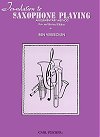
|
S112: Foundation to Saxophone Playing by Ben Vereecken. Carl Fischer, 1917, PB, 108 pages. Subtitled: An Elementary Method. While I don't think you would want to start a young beginner with the book, it has many pieces and exercises of progressive difficulty that will be useful to beginning and intermediate students. It also includes a fingering chart (of more recent vintage) and scales.
|
26.95

|
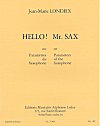
|
    S030: Hello! Mr. Sax by Jean-Marie Londeix. Alphonse Leduc, 1989, PB, 113 pages. Subtitled: Parameters of the Saxophone. Text is in French and English. Much of this book is devoted to extended techniques such as multiphonics, microtones, and special techniques of timbre and articulation. However, there sections on vibrato and other techniques that will be of interest to nearly all. Bass through sopranino are covered. S030: Hello! Mr. Sax by Jean-Marie Londeix. Alphonse Leduc, 1989, PB, 113 pages. Subtitled: Parameters of the Saxophone. Text is in French and English. Much of this book is devoted to extended techniques such as multiphonics, microtones, and special techniques of timbre and articulation. However, there sections on vibrato and other techniques that will be of interest to nearly all. Bass through sopranino are covered. |
57.80

|
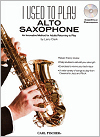
|
 S666: I Used to Play Alto Saxophone by Larry Clark. Carl Fischer, 2011, SS, 48 pages + CD. I Used to Play is a series for adults looking to get back into playing their instruments of yesteryear, and will help jump start their memory and comfort with music. Its #1 goal is to get people re-acquainted with their instrument(s) by not only reviewing theory and technique with etudes, but also providing them with types of music they want to play, like pop, jazz, and classical tunes. Each book contains a CD with audio MP3 files of complete performances of most songs, plus accompaniment-only play along versions. The CD also contains printable PDFs of piano parts for practice or performance opportunities. (The CD will only work in computers and CD players that play MP3s). It's just the push former players need to fall back in love with their instruments again! S666: I Used to Play Alto Saxophone by Larry Clark. Carl Fischer, 2011, SS, 48 pages + CD. I Used to Play is a series for adults looking to get back into playing their instruments of yesteryear, and will help jump start their memory and comfort with music. Its #1 goal is to get people re-acquainted with their instrument(s) by not only reviewing theory and technique with etudes, but also providing them with types of music they want to play, like pop, jazz, and classical tunes. Each book contains a CD with audio MP3 files of complete performances of most songs, plus accompaniment-only play along versions. The CD also contains printable PDFs of piano parts for practice or performance opportunities. (The CD will only work in computers and CD players that play MP3s). It's just the push former players need to fall back in love with their instruments again!
|
19.95

|
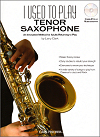
|
 S959: I Used to Play Tenor Saxophone by Larry Clark. Carl Fischer, 2013, SS, 48 pages + CD. A new version of this book for tenor sax with the same specifications as above. Click on the cover image to view the Table of Contents. S959: I Used to Play Tenor Saxophone by Larry Clark. Carl Fischer, 2013, SS, 48 pages + CD. A new version of this book for tenor sax with the same specifications as above. Click on the cover image to view the Table of Contents.
|
19.95

|
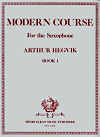
|
S251: Modern Course for the Saxophone Book 1 by Arthur Hegvik. Henri Elkan Music Publisher, 1971, SS, 32 pages. This method moves along at good pace with a range to high C, keys of one sharp and flat, and pieces with some 16th notes by the end. Features many short pieces rather than exercises. Includes fingering chart.
S252: Modern Course for the Saxophone Book 2 by Arthur Hegvik. Henri Elkan Music Publisher, 1974, SS, 32 pages. Introduces notes up to high F, alternate fingerings, more complex rhythms, staccato, and more keys. Includes fingering chart.
S253: Modern Course for the Saxophone Book 3 by Arthur Hegvik. Henri Elkan Music Publisher, 1977, SS, 36 pages. Continues articulation studies, introduces minor keys, chromatic exercises, and longer and more difficult etudes. Includes fingering chart. |
Book 1
14.95
 Book 2
14.95
Book 2
14.95
 Book 3
14.95
Book 3
14.95

|
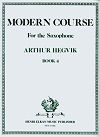
|
S254: Modern Course for the Saxophone Book 4 by Arthur Hegvik. Henri Elkan Music Publisher, 1983, SS, 36 pages. More difficult pieces and keys, mordent, etudes and pieces by Gariboldi, Barret, Stark, Burgmuller, Baermann and others. Includes fingering chart.
S255: Modern Course for the Saxophone Book 5 by Arthur Hegvik. Henri Elkan Music Publisher, 1983, SS, 40 pages. Aside from introducing turns, this book is all advanced intermediate etudes by Gariboldi, Nieman, Ferling, Barret, Klose, Berbiguier and more. Includes fingering chart
|
Book 4
14.95
 Book 5
14.95
Book 5
14.95

|
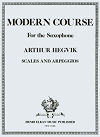
|
S257: Modern Course for the Saxophone Scales and Arpeggios by Arthur Hegvik. Henri Elkan Music Publisher, 1973, SS, 36 pages. All major and minor scales with basic exercises, major and minor melodic scales, harmonic minor scales, whole tone scales, various arpeggios (chord studies), etc. Includes fingering chart. This book is now out of print.
|
|
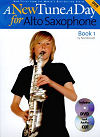
|
 S127: A New Tune a Day for Alto Saxophone DVD Edition by Ned Bennett. Boston Music Co., 2006, PB, 64 pages plus CD and DVD. A New Tune A Day features the same logical, gentle pace and keen attention to detail that made earlier editions so hugely popular and successful. Clear explanatory diagrams and photographs help guide the student through the lessons and achieve the very best in tone, technique and posture. The selection of music is fresh and exciting, including duets and rounds to inspire the student and ensure that those vital practice hours are never boring. The accompanying audio CD features a virtuoso performance and backing track for each pieces, as well as recorded examples to support the lessons. The DVD features lessons on: basic techniques, putting the instrument together, posture, looking after the instrument, basic music notation, and how to approach the first piece. S127: A New Tune a Day for Alto Saxophone DVD Edition by Ned Bennett. Boston Music Co., 2006, PB, 64 pages plus CD and DVD. A New Tune A Day features the same logical, gentle pace and keen attention to detail that made earlier editions so hugely popular and successful. Clear explanatory diagrams and photographs help guide the student through the lessons and achieve the very best in tone, technique and posture. The selection of music is fresh and exciting, including duets and rounds to inspire the student and ensure that those vital practice hours are never boring. The accompanying audio CD features a virtuoso performance and backing track for each pieces, as well as recorded examples to support the lessons. The DVD features lessons on: basic techniques, putting the instrument together, posture, looking after the instrument, basic music notation, and how to approach the first piece.
|
17.95

|
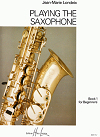
|
S405: Playing the Saxophone Book 1 for Beginners by Jean-Marie Londeix, English edition by Stephen Trier. Henry Lemoine, 1974, SS, 35 pages. A relatively fast moving method book which introduces the notes in small groups and features short exercises and tunes. Includes the full range of the saxophone, has scales for keys through 2 flats and 2 sharps. |
23.95

|
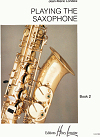
|
S406: Playing the Saxophone Book 2 by Jean-Marie Londeix, English edition by Stephen Trier. Henry Lemoine, 1974, SS, 94 pages. This book is in two parts. Part 1 of this book is a continuation of Book 1 with more challenging exercises (including sixteenth notes) and longer pieces. Part 2 is entirely focused on vibrato with pages of exercises and pieces. |
37.95

|
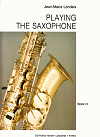
|
S407: Playing the Saxophone Book 3 by Jean-Marie Londeix, English edition by Stephen Trier. Henry Lemoine, 1974, SS, 55 pages. This book covers a number of subjects: melody (and free rhythm), rhythm and meter, phrasing, accents, signs of articulation and accentuation, and breathing. |
31.95

|
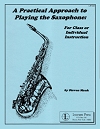
|
 S1166: A Practical Approach to Playing the Saxophone by Steven Mauk. Lyceum Press/Ensemble Publications, 1984/1986, SS, 62 pages. The book takes a gradual approach to learning the saxophone. It should be good for the first year and is suitable for both beginners and woodwind method classes. The author states that much of the material in this book was provided by Larry Teal. S1166: A Practical Approach to Playing the Saxophone by Steven Mauk. Lyceum Press/Ensemble Publications, 1984/1986, SS, 62 pages. The book takes a gradual approach to learning the saxophone. It should be good for the first year and is suitable for both beginners and woodwind method classes. The author states that much of the material in this book was provided by Larry Teal.
|
13.50

|
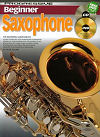
|
 S117: Progressive Beginner Saxophone by Peter Gelling. LPT Publishing, 2003, SS, 63 pages + CD and DVD. This is a very well illustrated, slow moving method that should be excellent for absolute beginners. Includes fingering charts, saxophone basics, and some elementary music theory. The DVD shows a saxophone being played, the music, and the fingerings on screen at the same time. S117: Progressive Beginner Saxophone by Peter Gelling. LPT Publishing, 2003, SS, 63 pages + CD and DVD. This is a very well illustrated, slow moving method that should be excellent for absolute beginners. Includes fingering charts, saxophone basics, and some elementary music theory. The DVD shows a saxophone being played, the music, and the fingerings on screen at the same time.
|
19.95

|
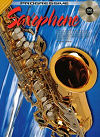
|
 S118: Progressive Saxophone by Peter Gelling. LPT Publishing, 2003, SS, 63 pages + CD. This book is very similar to the previous one. The only differences noted are a few duets and several different tunes. S118: Progressive Saxophone by Peter Gelling. LPT Publishing, 2003, SS, 63 pages + CD. This book is very similar to the previous one. The only differences noted are a few duets and several different tunes.
|
16.95

|
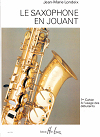
|
S401: Le Saxophone en Jourant 1er A 'lusage des débutants by Jean-Marie Londeix. Henry Lemoine, 1964, SS, 47 pages. Entirely in French. The first book in this series. It covers the same instructional material as the English language version (S405) but has 10 additional pages of duets and trios.
|
27.50

|
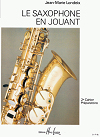
|
S402: Le Saxophone en Jourant 2e Cahier Préparatoire by Jean-Marie Londeix. Henry Lemoine, 1966, SS, 60 pages. Entirely in French. It is a continuation of the first book in the series with more challenging exercises (including sixteenth notes) and longer pieces. This book covers the same material as our S406 Book 2, Part 1, but in French.
|
32.95

|
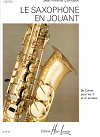
|
S403: Le Saxophone en Jourant 3e Cahier pour les 3e et 4e années by Jean-Marie Londeix. Henry Lemoine, 1966, SS, 41 pages. Entirely in French. It is focused on expression and vibrato and is at least the same difficulty level as S404. It covers the same material as our S406 Book 2, Part 2, but in French.
|
24.95

|
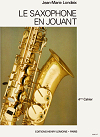
|
S404: Le Saxophone en Jourant 4e Cahier by Jean-Marie Londeix. Henry Lemoine, 1966, SS, 60 pages. Entirely in French. This book covers a number of subjects: melody (and free rhythm), rhythm and meter, phrasing, accents, signs of articulation and accentuation, and breathing. This book covers the same material as our S407 but in French.
|
32.95

|
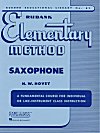
|
S069: Rubank Elementary Method Saxophone by N. W. Hovey. Rubank, 1934, SS, 48 pages. A fundamental course for individual or like-instrument class instruction. Includes fingering chart. |
7.95

|
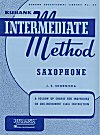
|
S070: Rubank Intermediate Method Saxophone by J.E. Skornicka. Rubank, 1938, SS, 48 pages. A follow up course for individual or like-instrument class instruction. Introduces many techniques and concepts such as expression markings and accents, various types of articulation, grace notes, trills, scale and chord studies. A number of duets and trios are included. Includes fingering chart. |
7.95

|
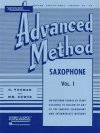
|
S071: Rubank Advanced Method Saxophone Vol. 1 by H. Voxman and Wm. Gower. Rubank, 1940, SS, 72 pages. This book is intended to follow any beginning or intermediate method. It includes scales and chords studies, studies in melodic interpretation (all duets), studies in articulation, fingering exercises, and ornamentation. All of the material in this books is in keys with no more than two sharps or flats. Includes fingering chart. |
9.95

|
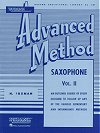
|
S072: Rubank Advanced Method Saxophone Vol. 2 by H. Voxman. Rubank, 1957, SS, 80 pages. This book covers similar material to volume 1 of the Advanced Method but in keys from three to five sharps and flats. Includes fingering chart. |
9.95

|
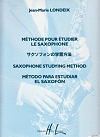
|
S400: Saxophone Studying Method by Jean-Marie Londeix. Lemoine, 1997, SB, 85 pages. This is not a method book in the conventional sense, but instead is a guide and text book for studying the saxophone. It is in four languages: French, Japanese, English and Spanish, each in their own vertical column. There are many specific references to books of study and saxophone repertoire. Subjects covered include basic techniques and equipment, etudes, and literature (both orchestral and solo). A very detailed book with many diagrams and musical examples.
|
35.95

|
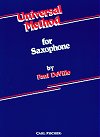
|
S044: Universal Method for Saxophone by Paul DeVille. Carl Fischer, 1908, PB, 320 pages. A classic and massive saxophone method loaded with exercises, pieces, and some duets.
 S044a: Universal Method for Saxophone by Paul DeVille. Carl Fischer, 1908, SB, 320 pages. A classic and massive saxophone method loaded with exercises, pieces, and some duets. The new spiral bound edition of this book, identical except for the binding. S044a: Universal Method for Saxophone by Paul DeVille. Carl Fischer, 1908, SB, 320 pages. A classic and massive saxophone method loaded with exercises, pieces, and some duets. The new spiral bound edition of this book, identical except for the binding.
|
S044
29.95

S044a
39.95

|





















 S1166: A Practical Approach to Playing the Saxophone by Steven Mauk. Lyceum Press/Ensemble Publications, 1984/1986, SS, 62 pages. The book takes a gradual approach to learning the saxophone. It should be good for the first year and is suitable for both beginners and woodwind method classes. The author states that much of the material in this book was provided by Larry Teal.
S1166: A Practical Approach to Playing the Saxophone by Steven Mauk. Lyceum Press/Ensemble Publications, 1984/1986, SS, 62 pages. The book takes a gradual approach to learning the saxophone. It should be good for the first year and is suitable for both beginners and woodwind method classes. The author states that much of the material in this book was provided by Larry Teal.










